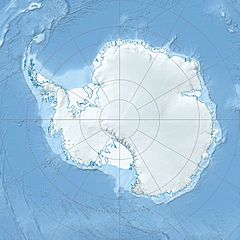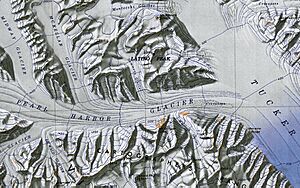Latino Peak facts for kids
Quick facts for kids  
The Antarctica Service Medal
This medal honors brave service in Antarctica. |
|
Its ribbon shows the colors
of the Antarctic sky and ice. |
Latino Peak is a tall mountain peak in Antarctica. It stands at about 2,290 meters (that's over 7,500 feet!) high. This impressive peak is found in the Victory Mountains of Victoria Land, a part of Antarctica.
It is located about 4 nautical miles (or 7 kilometers) south-southwest of Mount Hazlett. Latino Peak is the highest point where two large glaciers, the Tucker Glacier and the Pearl Harbor Glacier, meet. The western side of the peak is drained by another glacier called Summers Glacier.
About Latino Peak
Latino Peak is a significant landmark in the icy landscape of Antarctica. Its height makes it stand out among the surrounding mountains. The area around the peak is very cold and covered in ice and snow all year round.
How Latino Peak Got Its Name
Latino Peak was mapped by the United States Geological Survey (USGS) between 1960 and 1964. They used surveys and aerial photos taken by the United States Navy.
The peak was named by the Advisory Committee on Antarctic Names to honor Terry L. Latino. He was a "SeaBee" in the U.S. Navy. SeaBees are members of the U.S. Navy Construction Battalions. They are known for building things, even in tough places.
Terry L. Latino spent time at McMurdo Station on Ross Island in Antarctica. He was part of U.S. Navy expeditions during the summers of 1965 and 1966. He also stayed through the harsh Antarctic winter of 1967 as part of Operation Deep Freeze. This operation helps support scientific research in Antarctica. Terry L. Latino also served his country in the Vietnam War in 1968–69.



